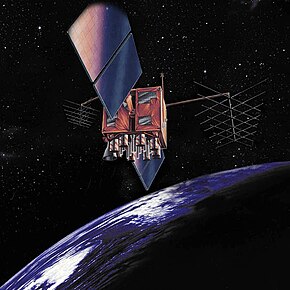 A Block IIR GPS satellite | |
| Names | Navstar 43 GPS IIR-2 GPS SVN-43 |
|---|---|
| Mission type | Navigation |
| Operator | U.S. Air Force |
| COSPAR ID | 1997-035A [1] |
| SATCAT no. | 24876 |
| Mission duration | 10 years (planned) 27 years, 2 months and 19 days (elapsed) |
| Spacecraft properties | |
| Spacecraft | GPS IIR |
| Spacecraft type | GPS Block IIR[2] |
| Bus | AS-4000 |
| Manufacturer | Lockheed Martin |
| Launch mass | 2,032 kg (4,480 lb) |
| Start of mission | |
| Launch date | 23 July 1997, 03:43:01 UTC |
| Rocket | Delta II 7925-9.5 (Delta D245) |
| Launch site | Cape Canaveral, LC-17A |
| Contractor | McDonnell Douglas |
| Entered service | 22 August 1997 |
| Orbital parameters | |
| Reference system | Geocentric orbit[3] |
| Regime | Medium Earth orbit (Semi-synchronous) |
| Slot | F3 (slot 3 plane F) |
| Perigee altitude | 19,023 km (11,820 mi) |
| Apogee altitude | 20,224 km (12,567 mi) |
| Inclination | 54.90° |
| Period | 713.00 minutes |
USA-132, also known as GPS IIR-2 and GPS SVN-43, is an American navigation satellite which forms part of the Global Positioning System. It was the second Block IIR GPS satellite to be launched, out of thirteen in the original configuration, and twenty one overall. GPS IIR-1 failed to achieve orbit, so USA-132 was the first successful Block IIR satellite. It was built by Lockheed Martin, using the AS-4000 satellite bus.[2]
- ^ "Display: Navstar 43 1997-035A". NASA. Retrieved 11 July 2012.
 This article incorporates text from this source, which is in the public domain.
This article incorporates text from this source, which is in the public domain.
- ^ a b Cite error: The named reference
GSPwas invoked but never defined (see the help page). - ^ Cite error: The named reference
Trajectorywas invoked but never defined (see the help page).